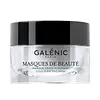What's inside
What's inside
 Key Ingredients
Key Ingredients

 Benefits
Benefits

 Concerns
Concerns

 Ingredients Side-by-side
Ingredients Side-by-side

Water
Skin ConditioningKaolin
AbrasiveGlycerin
HumectantAlcohol
AntimicrobialCaprylic/Capric Triglyceride
MaskingGlyceryl Stearate
Emollient1,2-Hexanediol
Skin ConditioningPEG-100 Stearate
Acrylates/C10-30 Alkyl Acrylate Crosspolymer
Emulsion StabilisingArachidyl Alcohol
EmollientArachidyl Glucoside
EmulsifyingBehenyl Alcohol
EmollientChlorphenesin
AntimicrobialParfum
MaskingCI 77499
Cosmetic ColorantMenthol
MaskingPolyacrylate-13
Polyisobutene
Polysorbate 20
EmulsifyingSodium Hydroxide
BufferingSorbitan Isostearate
EmulsifyingWater, Kaolin, Glycerin, Alcohol, Caprylic/Capric Triglyceride, Glyceryl Stearate, 1,2-Hexanediol, PEG-100 Stearate, Acrylates/C10-30 Alkyl Acrylate Crosspolymer, Arachidyl Alcohol, Arachidyl Glucoside, Behenyl Alcohol, Chlorphenesin, Parfum, CI 77499, Menthol, Polyacrylate-13, Polyisobutene, Polysorbate 20, Sodium Hydroxide, Sorbitan Isostearate
Water
Skin ConditioningJojoba Esters
EmollientGlycerin
HumectantHamamelis Virginiana Water
AstringentBehenyl Alcohol
EmollientCaprylic/Capric Triglyceride
MaskingKojic Acid
AntioxidantRetinol
Skin ConditioningPolysorbate 20
EmulsifyingButylene Glycol
HumectantAlcohol
AntimicrobialSucrose Stearate
EmollientOlea Europaea Leaf Extract
PerfumingCitrus Limon Peel Oil
MaskingCitrus Aurantium Dulcis Flower Oil
AstringentDicaprylyl Ether
EmollientCaprylyl Glycol
EmollientMalic Acid
BufferingZanthoxylum Americanum Bark Extract
MaskingXanthan Gum
EmulsifyingPhenoxyethanol
PreservativeSorbic Acid
PreservativeWater, Jojoba Esters, Glycerin, Hamamelis Virginiana Water, Behenyl Alcohol, Caprylic/Capric Triglyceride, Kojic Acid, Retinol, Polysorbate 20, Butylene Glycol, Alcohol, Sucrose Stearate, Olea Europaea Leaf Extract, Citrus Limon Peel Oil, Citrus Aurantium Dulcis Flower Oil, Dicaprylyl Ether, Caprylyl Glycol, Malic Acid, Zanthoxylum Americanum Bark Extract, Xanthan Gum, Phenoxyethanol, Sorbic Acid
 Reviews
Reviews

Ingredients Explained
These ingredients are found in both products.
Ingredients higher up in an ingredient list are typically present in a larger amount.
Alcohol comes in many different forms. Different types of alcohol will have different effects on skin. This ingredient is usually an astringent alcohol.
These alcohols are drying on the skin. They may strip away your skin's natural oils and even damage your skin barrier. Astringent alcohols may also irritate skin.
Other types of astringent alcohols include:
According to the National Rosacea Society based in the US, you should be mindful of products with these alcohols in the top half of ingredients.
Any type of sanitizing product will have high amounts of alcohol to help kill bacteria and viruses.
Fatty alcohols come from plant oils such as coconut oil. These can help hydrate the skin and are non-irritating. Some fatty alcohols include cetyl and stearyl alcohol.
Learn more about AlcoholBehenyl Alcohol is a type of fatty alcohol (these are different from the drying, solvent alcohols).
Fatty Alcohols have hydrating properties and are most often used as an emollient or to thicken a product. They are usually derived from natural fats and oils; behenyl alcohol is derived from the fats of vegetable oils.
Emollients help keep your skin soft and hydrated by creating a film that traps moisture in.
In 2000, Behenyl Alcohol was approved by the US as medicine to reduce the duration of cold sores.
Learn more about Behenyl AlcoholThis ingredient is an emollient, solvent, and texture enhancer. It is considered a skin-softener by helping the skin prevent moisture loss.
It helps thicken a product's formula and makes it easier to spread by dissolving clumping compounds.
Caprylic Triglyceride is made by combining glycerin with coconut oil, forming a clear liquid.
While there is an assumption Caprylic Triglyceride can clog pores due to it being derived from coconut oil, there is no research supporting this.
Learn more about Caprylic/Capric TriglycerideGlycerin is already naturally found in your skin. It helps moisturize and protect your skin.
A study from 2016 found glycerin to be more effective as a humectant than AHAs and hyaluronic acid.
As a humectant, it helps the skin stay hydrated by pulling moisture to your skin. The low molecular weight of glycerin allows it to pull moisture into the deeper layers of your skin.
Hydrated skin improves your skin barrier; Your skin barrier helps protect against irritants and bacteria.
Glycerin has also been found to have antimicrobial and antiviral properties. Due to these properties, glycerin is often used in wound and burn treatments.
In cosmetics, glycerin is usually derived from plants such as soybean or palm. However, it can also be sourced from animals, such as tallow or animal fat.
This ingredient is organic, colorless, odorless, and non-toxic.
Glycerin is the name for this ingredient in American English. British English uses Glycerol/Glycerine.
Learn more about GlycerinPolysorbate 20 is made by combining ethoxylation of sorbitan, ethylene oxide, and lauric acid. It is a mild cleansing agent, surfactant, and emulsifier.
As a surfactant, it helps collect dirt and oils for washing. Emulsifiers prevent oils and water from separating.
Polysorbate 20 also adds scent to a product. Since it is made using sorbitol, it has a sweet scent. Sorbitol can also be found in fruits such as apples and peaches.
The lauric acid used to create Polysorbate 20 is often derived from coconuts.
Polysorbate 20 may not be fungal acne safe.
Learn more about Polysorbate 20Water. It's the most common cosmetic ingredient of all. You'll usually see it at the top of ingredient lists, meaning that it makes up the largest part of the product.
So why is it so popular? Water most often acts as a solvent - this means that it helps dissolve other ingredients into the formulation.
You'll also recognize water as that liquid we all need to stay alive. If you see this, drink a glass of water. Stay hydrated!
Learn more about Water